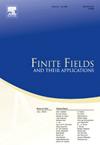特征3超椭圆曲线的a数分布
IF 1.2
3区 数学
Q1 MATHEMATICS
引用次数: 0
摘要
本文给出了一种计算有限域Fq上具有给定a数的g属超椭圆曲线所占比例的新方法。在特征三中,该方法给出了形式为Y2=f(X)且f(X)∈Fq[X]的单调和无立方概率曲线的精确概率,与Cais等人在先前工作中提供的数据相匹配。这些结果足以在限制为无平方f时对这些概率(用q表示)进行精确估计。因此,对于正整数a和g,我们证明了由a数为a的曲线组成的g属超椭圆曲线模空间的非空层的余维为2a−1。这与层的协维为a(a+1)/2的阿贝尔变化的模空间的类似结果形成对比。最后,我们的结果允许Cais等人的另一种启发式猜想-一种与可用数据相匹配的猜想。本文章由计算机程序翻译,如有差异,请以英文原文为准。
The distribution of a-numbers of hyperelliptic curves in characteristic three
In this paper we present a new approach to counting the proportion of hyperelliptic curves of genus g defined over a finite field with a given a-number. In characteristic three this method gives exact probabilities for curves of the form with monic and cubefree—probabilities that match the data presented by Cais et al. in previous work. These results are sufficient to derive precise estimates (in terms of q) for these probabilities when restricting to squarefree f. As a consequence, for positive integers a and g we show that the nonempty strata of the moduli space of hyperelliptic curves of genus g consisting of those curves with a-number a are of codimension . This contrasts with the analogous result for the moduli space of abelian varieties in which the codimensions of the strata are . Finally, our results allow for an alternative heuristic conjecture to that of Cais et al.—one that matches the available data.
求助全文
通过发布文献求助,成功后即可免费获取论文全文。
去求助
来源期刊
CiteScore
2.00
自引率
20.00%
发文量
133
审稿时长
6-12 weeks
期刊介绍:
Finite Fields and Their Applications is a peer-reviewed technical journal publishing papers in finite field theory as well as in applications of finite fields. As a result of applications in a wide variety of areas, finite fields are increasingly important in several areas of mathematics, including linear and abstract algebra, number theory and algebraic geometry, as well as in computer science, statistics, information theory, and engineering.
For cohesion, and because so many applications rely on various theoretical properties of finite fields, it is essential that there be a core of high-quality papers on theoretical aspects. In addition, since much of the vitality of the area comes from computational problems, the journal publishes papers on computational aspects of finite fields as well as on algorithms and complexity of finite field-related methods.
The journal also publishes papers in various applications including, but not limited to, algebraic coding theory, cryptology, combinatorial design theory, pseudorandom number generation, and linear recurring sequences. There are other areas of application to be included, but the important point is that finite fields play a nontrivial role in the theory, application, or algorithm.

 求助内容:
求助内容: 应助结果提醒方式:
应助结果提醒方式:


